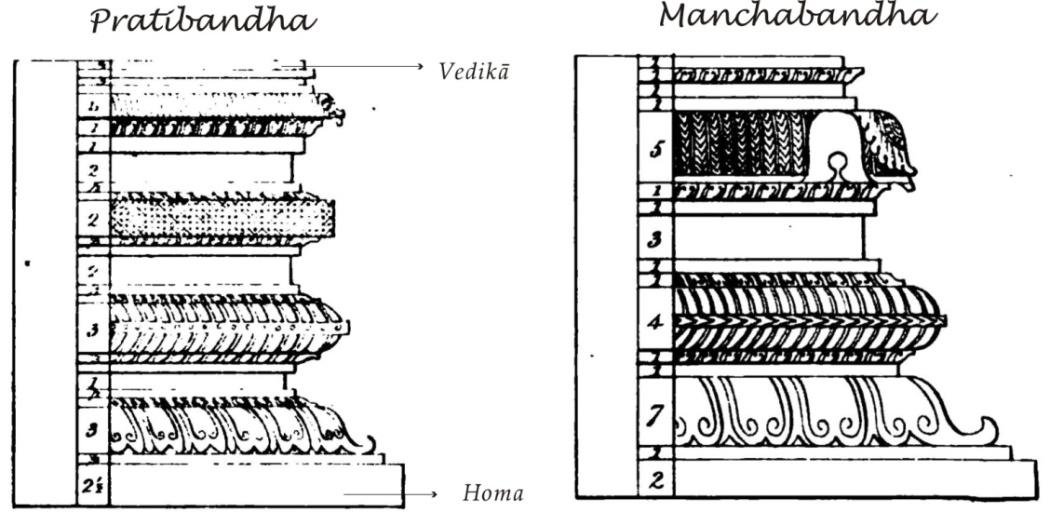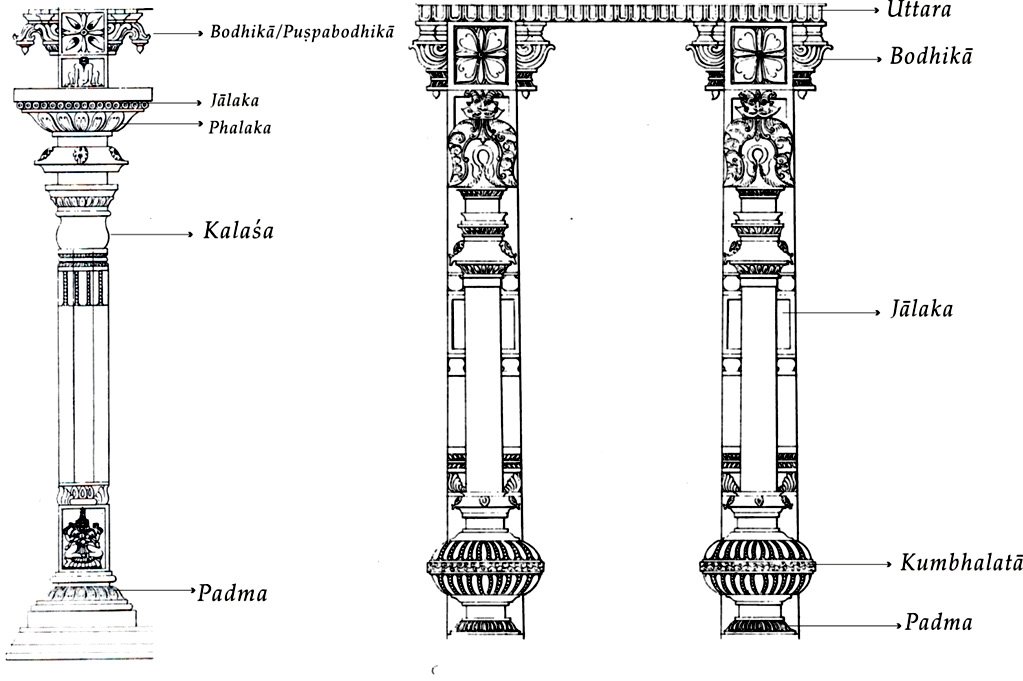Kashyapa Shilpa-shastra (study)
by K. Vidyuta | 2019 | 33,520 words
This page relates ‘Technical terms for the component parts of the temple’ of the study on the Kashyapa Shilpa-shastra (in English) with special reference to the characteristics of Prakara (temple-components), Mandapa (pavilions) and Gopura (gate-house). The Silpa-Sastras refers to the ancient Indian science of arts and crafts, such as sculpture, architecture and iconography. This study demonstrates the correlatation between ancient Indian monuments (such as temples and sculptures) and the variety of Sanskrit scriptures dealing with their construction.
4 (b). Technical terms for the component parts of the temple
[Note: All the pictures in this section are taken from Essays on the Architecture of the Hindus, by Ram Raz, 1834, unless otherwise mentioned.]
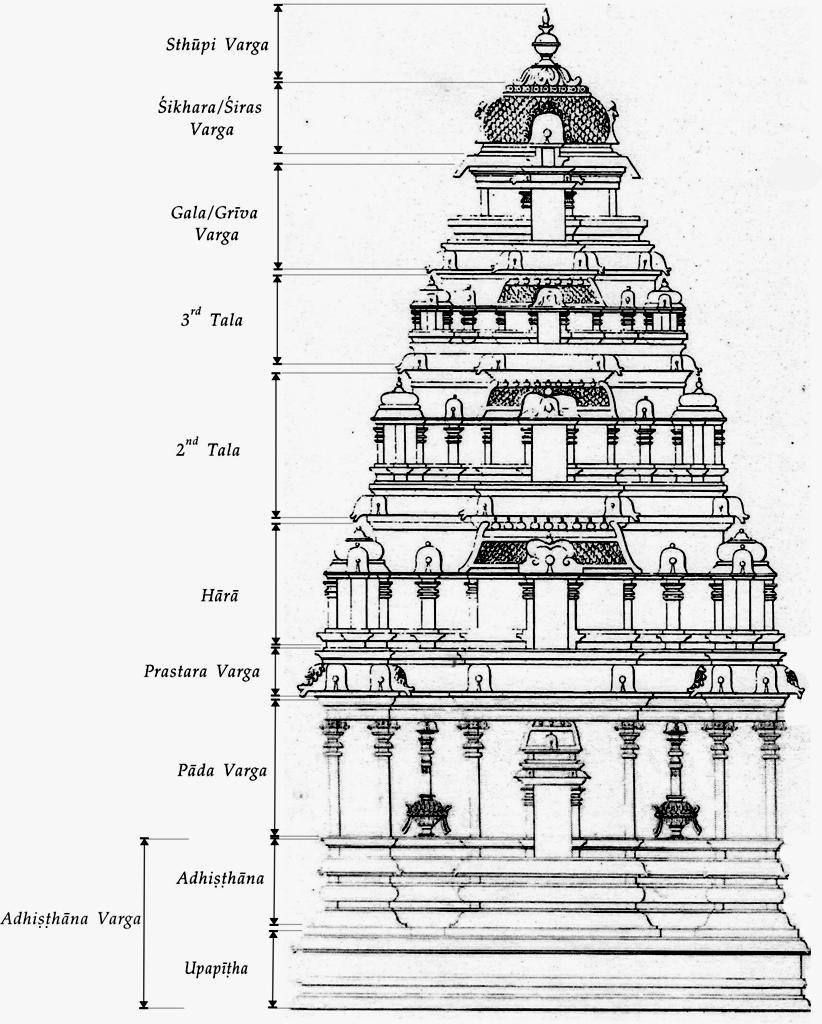 The next important aspect that one must know before delving into the actual construction of temple architecture, are the various terms that are used in the Āgamas and Kāśyapa Śilpaśāstra while laying out the rules for constructing the Prākāra, Maṇḍapa and the Gopuras. As is tradition, the measurements and the parts of the prākāra, maṇḍapa and the gopura depend upon the mūla-harmya (main temple).
The next important aspect that one must know before delving into the actual construction of temple architecture, are the various terms that are used in the Āgamas and Kāśyapa Śilpaśāstra while laying out the rules for constructing the Prākāra, Maṇḍapa and the Gopuras. As is tradition, the measurements and the parts of the prākāra, maṇḍapa and the gopura depend upon the mūla-harmya (main temple).
The fundamental term “vastu” denotes the ground as the Mayamata (II. 2) says:
bhūmi prāsādayānāni śayaṃna ca caturvidham |
bhūrevamukhyavastu syāt tatra jātāni yāni hi ||
According to the Ajitāgama[1] (XII. 44cd-5) and other āgamas, the main temple is divided into 6 sections (ṣaḍvargas). They are the adhiṣṭhāna varga, pāda varga, prastara varga, grīva varga, śikhara varga and the sthūpi vargas. Each of these vargas is in-turn made up of various layers or architectural components.
Also the last three vargas viz., grīva, śikhara and sthūpi, are collectively termed as Prāsāda varga:
ādyaṃ syāttadadhiṣṭhānaṃ dvitīyaṃ pādamucyate ||
prastaraṃ tu tṛtīyaṃ syāt caturthaṃ grīvamucyate |
pañcamaṃ śikharaṃ ṣaṣṭhaṃ sthūpirityabhidhīyate ||
The technical terms depicting the various components of these above mentioned vargas that are relevant to the construction of the prākāra, maṇḍapa and gopura are enumerated as follows:
(a) Adhiṣṭhāna varga:
(1) According to the Āgamas this varga constitutes the upapīṭha and the adhiṣṭhāna portions of the temple structure.
The upapīṭha is defined by Ajitāgama (XI. 1) to enable the elevation of the prāsādas, maṇḍapas, etc. as a pedestal for the height of them and as a decorative component:
prāsādāmaṇṭa pādīnāmunnatārthaṃ viśeṣataḥ |
śobhārthaṃ ca samuddiṣṭamupapīṭhamataḥ śṛṇu ||
The components of the upapīṭha, that occurs in the next three chapters of the thesis are the prakṛti, janma or upāna or bhauma, etc. and this collection is dealt with in the Kāśyapa Śilpaśāstra in its 5th chapter.
The Kāmikāgama (I. 52. 6cd, 9) defines that the first level of the ground is known as prakṛti; the layer above this is called the janma or janma bhū, the plinth and this is also called as upāna and bhauma:
ādau prakṛtibhūmisyāt triprakārā tu sā smṛtā ||
......... prakṛtyupari janmabhūḥ |
tadupānamiti proktāsaiva bhaumā prakīrtitā ||
The different types of upapīṭha (See Fig. below) are–pratibhadra, vājibhadra, mañcabhadra, candrabhadra and so on, depending upon the permutation and combination of the various components of the pedestal.
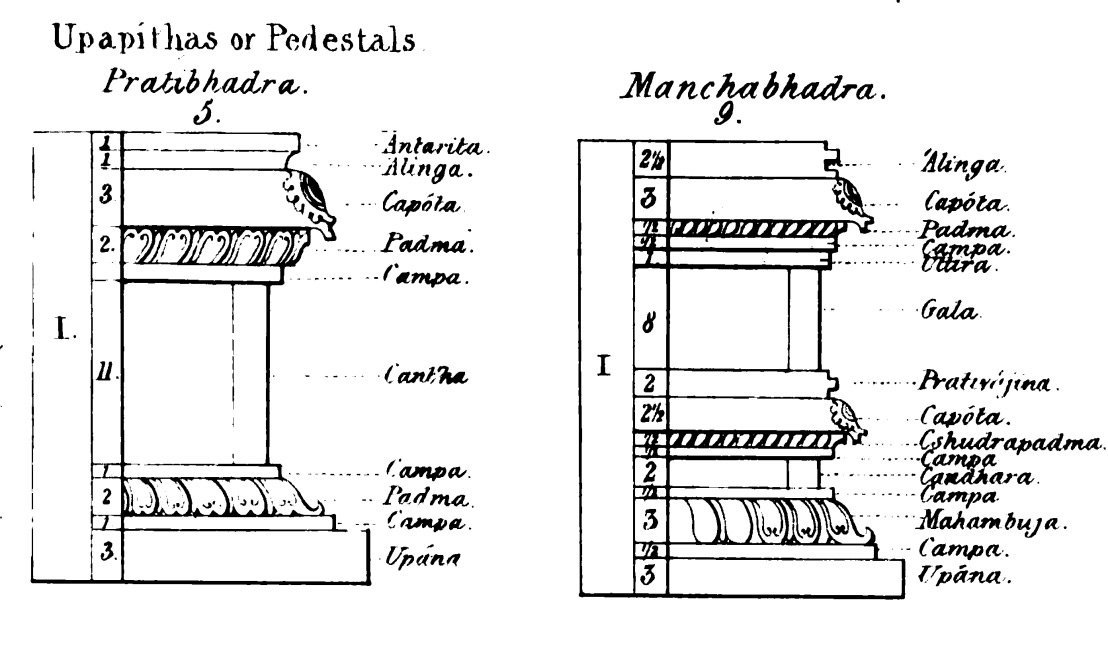
(2) That which stands above the plinth is called the adhiṣṭhāna (See Fig. below) or the base.
Kāśyapa Śilpaśāstra deals with this in the 6th Chapter of the text, where Kāśyapa lists the synonyms for the adhiṣṭhāna as dharātala, adhiṣṭhāna, ādhāra, tala, bhuvana, pṛthvī and bhūmi (VI. 1cd-2ab)[2] :
dharātalamadhiṣṭhānaṃ ādhāraṃ dharaṇītalam ||
bhuvanaṃ pṛthivī bhūmiḥ paryāyavacanādibhiḥ |
Kāśyapa Śilpaśāstra uses a term homa to denote a particular part of this varga. This term is not mentioned in the Āgamas in this sense. After interviewing some Sthapatis[3] who have practical knowledge about the components of the temple and textual knowledge, it is concluded that homa is a part of the adhiṣṭhāna or the component of the base from which a pillar is erected.
Another important component of the adhiṣṭhāna is the Vedikā or Vedi.
Kāśyapa Śilpaśāstra (X. 1cd-2ab) mandates that the Vedikā must be laid over the adhiṣṭhāna and below the pillars or above the prastara:
adhiṣṭhānopariṣṭhāttu staṃbhamūle tu kalpayet ||
prastarasyopariṣṭācca kartavyā vedikā dvija |
By the above statement it is clear that all the components of the adhiṣṭhāna is repeated for every storey of the harmya or the gopura.
(b) Pāda varga:
As the name of this section suggests, this varga is mainly made up of pillars or pādas. Kāśyapa Śilpaśāstra enlists the various synonyms of the pillars as stambha, talipa, caraṇa, jaṅgama, sthāṇu, sthūṇa and pāda.
Other than these words, any synonym for legs in Sanskrit is used to denote them (VIII. 2):
staṃbhaṃ ca talipaṃ caiva caraṇaṃ jaṅgameva ca |
sthaṇuḥ sthūṇaṃ ca pādaṃ ca paryāya vacanāni ca ||
The components of the pādavarga that are used frequently in the chapters of Kāśyapa Śilpaśāstra that are taken up for study in this thesis, are bodhika, phalaka, kalaśa, jālaka, kumbhalatā, toraṇa, etc.
Of these, Kāśyapa prescribes the neck portion of the pillar as the place for a jālaka (Kāśyapa Śilpaśāstra, XI. 1cd):
pādavargagale caiva jālakasthanamucyate ||
(c) Prastara varga:
The Prastara (entablature) is also called mañcaka, this is the part that acts as a roof and connects the adhiṣṭhāna and pādavarga with the prāsāda varga. Above the bodhikā, vedikā is placed and above this the uttara (architrave) is laid out.
The prastara varga extends from the uttara until the prati-vājana (upper fillet) (Kāmikāgama, I. 54. 1cd-2):
uttaraṃ vājanaṃ caiva muṣṭibandhaṃ mṛṇālikam ||
daṇḍikāvalayakṣudra gopānācchādanāni ca |
āliṅgāntaritā caiva pratyaṅgaṃ vājanaṃ kramāt ||
The components of this prastara (See Fig. below) are uttara, vājana, muṣṭibandha, mṛṇālika, daṇḍikā (tulā), valaya, kṣudra daṇḍika, gopāna, chādana, aliṅga, antarita and prati-vājana.
Other than these, the prastara must be decorated with kapota, which is designed above the vājana and which may or may not be endowed with a gopāna (Kāmikāgama, I. 18. 11cd-12ab):
vājanāttu kapotasya nīvraṃ cālaṃbanaṃ samam ||
kapotaṃ gopānasahitaṃ gopānarahitaṃ tu vā |
There is a moulding called the jayantī that is to be designed above the beam (tulā) in the prastara (Kāśyapa Śilpaśāstra, I. 54. 13cd):
tulāvistāratāroccā jayantī syāttulopari ||
The Mānasāra (XVI. 9cd-10), meanwhile declares that kapota, prastaram, mañca, pracchādana, gopāna, vitāna, valabhī, mattavāraṇa, vidhāna and lupā are synonyms:
kapotaṃ prastaraṃ caiva mañcaṃ pracchādanaṃ tathā ||
gopānaṃ ca vitānaṃ ca valabhī mattavāraṇam |
vidhānaṃ ca lupaṃ caivamete paryāyavācakāḥ ||
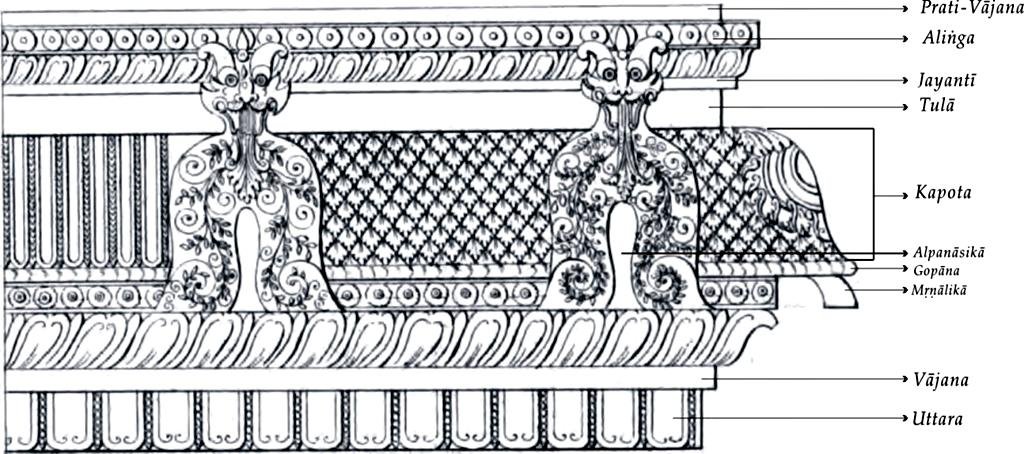
(d) Gala/ Grīva varga[4] :
The next varga is the Gala or Grīva varga which forms the neck portion of the prāsāda, thus this name.
The Ajitāgama (XIV. 64cd-5ab) states that gala is to be designed above the prastara and the first component of the gala must be a vedikā:
......... galaṃ syātprastaropari ||
tanmūle vedikāṃ kuryāttasya lakṣaṇamucyate |
Kāśyapa Śilpaśāstra (XIX. 6) records the different types of gala that are to be constructed for the Nāgara, Vesara and Drāviḍa styles of temples.
That is, the gala of Nāgara style should be square shaped, that of Drāviḍa must be octagonal and that of Vesara must be circular:
vedāśraṃ nāgare kaṇṭhaṃ vasvaśraṃ draviḍe galam |
vṛttaṃ tu vesare harmye galamānākulaṃ nayet ||
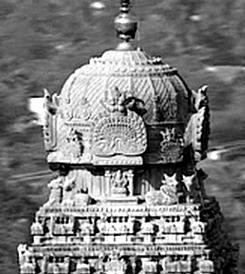
(e) Śikhara varga:
The śikharas are given eight specific names depending upon eight different heights as per Kāmikāgama (I. 57. 4):
pāñcālaṃ cāpi vaidehaṃ māgadhaṃ cāpi kauravam |
kośalaṃ śaurasenaṃ ca gāndhāraṃ patrikaṃ tathā ||
The gala is connected to the śikhara by means of a vertical projection called the lupā or lūpa (often translated as rafters).
This lupā is said to be of five types, viz., Madhya, madhyakarṇa, vyākarṇa, anukoṭi and koṭilupā (Kāmikāgama, I. 57. 22):
madhyaṃ ca madhyakarṇaṃ ca vyākarṇamanukoṭikam |
koṭi rityevamucyante pañcavarṇalupāḥ kramāt ||
Also, Kāśyapa states that the śikhara must be endowed with lalāṭanāsikā and especially with bhadra nās•ikas (Kāśyapa Śilpaśāstra, XXI. 1cd, 23cd):
lalāṭanāsikākhyātaṃ śikhare tārasadṛśam ||
kalpayettu viśeṣeṇa śikhare bhadranāsikam ||
(f) Sthūpi varga:
The sthūpi is the finial part of the temple vimāna.
As per Kāmikāgama, its height must be equal to or half the height of the lotus designed below it (I. 58. 1cd):
padmoccaṃ vārdhabhāgo vā tadūrdhve sthūpikāyatiḥ ||
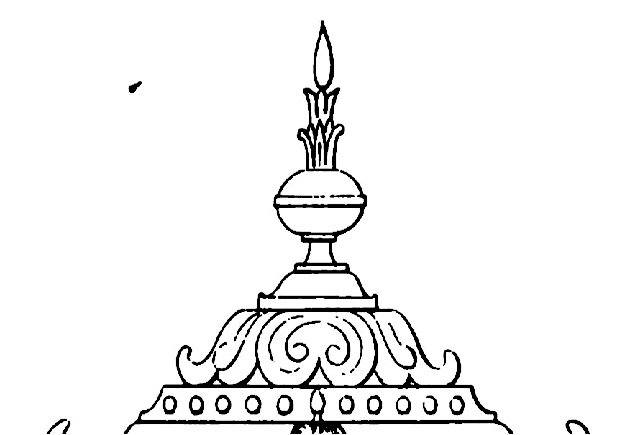
(g) Hāra varga:
Other than the above mentioned vargas, depending upon the number of storeys of the prāsāda, a section termed as hāra is constructed which is endowed with components like kūṭa-koṣṭha, karṇa-kūṭa, śālā, pañjara, and hārāntara. This hāra varga represents the decorative projections of each storey of both the Vimāna and the Gopura.
The kūṭa and śāla are structures that represent a miniature vimāna from adhiṣṭhāna until the sthūpi. The hāra is translated as a parapet which is well embellished with sculptures or with just the above components. This hāra is also endowed with projecting structures called bhadra that are embellished with the kūṭa-koṣṭhas and pañjaras. Kāśyapa Śilpaśāstra explains the kūṭa-koṣṭha-pañjara[5] lakṣaṇas in its 39th Chapter.

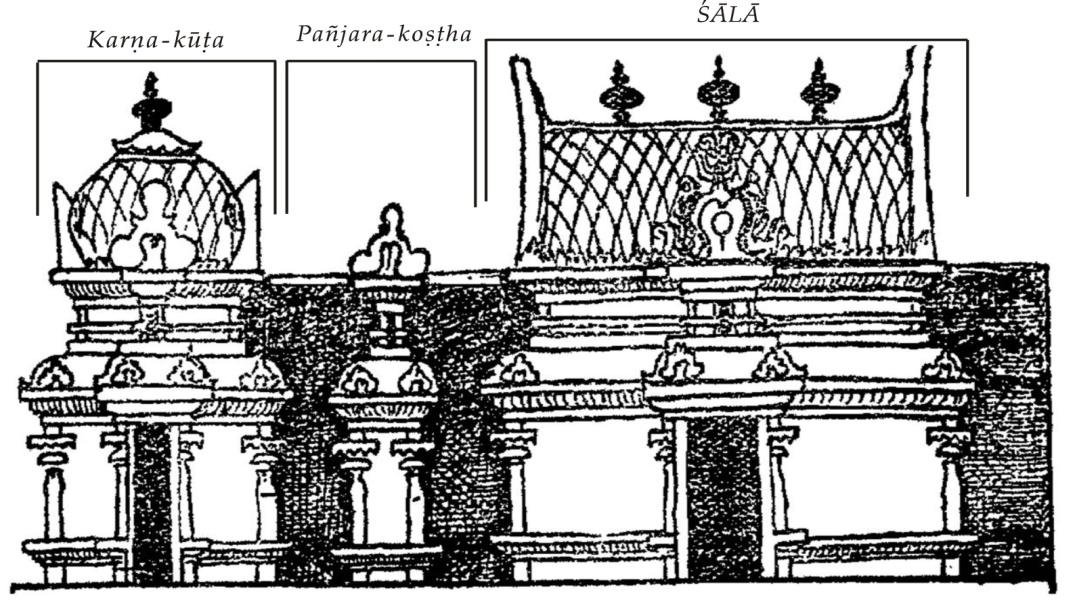
Footnotes and references:
[1]:
Cf. Ajitāgama, Vol. II, Cr. Ed. by N. R. Bhatt, French Institute of Indology, Pondichery, 1967.
[2]:
Ajitāgama (I. 5. 18), gives masūraka, vasvādhāra and dhṛtāla as synonyms of the adhiṣṭhāna:
masūrakamadhiṣṭhānaṃ vasvādhāraṃ dhṛtālakam |
catvāryetāni nāmāni paryāyavacanāni ||
[3]:
Sri Umapathi Acharya, an authentic traditional Sthapati from Kumbakonam.
[4]:
Photo Coutsey: The gala of Bṛhadīśvara temple, Tanjore, from web.
[5]:
Photo courtesy: Dravidian Architecture by G. Jouveau Dubreuil, New Delhi, 1987.

